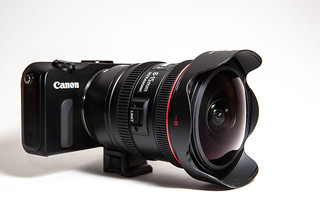Fisheye lens

|
| Canon EF8-15f4L fish-eye zoom image by e_impact (Image rights) |
Fisheye lenses cover an extremely wide angle with angle of view in excess of 100° and even more than 180°. These lenses have a short focal length, have a very large Depth of field but will yield an image with strong distortion, with the image appearing convez, bulging at the center and fading towards the edges. While most lenses are designed to minimise distortion, Fisheye lenses project severe distortion away from the image centre: only straight lines that pass through the centre will appear straight, while the rest of the image appears curved. Similar to the hemispherical view that fishes would see underwater.
Originally developed for metereological uses (sky-lenses), as invented by Robert W. Wood in 1906 and perfected by Robin Hill in 1924[1], it was used later for aerial reconnaissance and technical purposes. These lenses began appearing in the 1960s for photographers, very useful for panoramic and small space photography their distortion limits their use in general photography.
The lenses come in two varieties: circular fisheye lenses, which project a circular 180 degree angle of view image within the film frame; and full-frame fisheye lenses, which fill the frame with 180 degree angle of view diagonally.
Origin
|
The term "fisheye" comes from the similarly distorted view of the dry world when looking up from underwater. Because of light refraction when entering water, the image seen of the above water world when looking up from underwater is a circle with extreme distortion at the edges, just like a circular fisheye lens. This is the only way to project a 180 degree image onto a flat plane and the original use of these lenses was photographing cloud cover.
Full-frame fisheye lenses were developed for general photography but the extreme distortion is obvious. Jonathan Eastland comments that they are "...difficult to use with originality".[2]
The given focal length is only relevant for the image centre, towards the edges it is shorter still and the image compressed.
Notes
- ↑ British Patent GB225398A Improvements in photographic lenses. Hill, R., and Beck, Ltd., R. & J. Dec. 20, 1923
- ↑ Jonathan Eastland, The Leica R Compendium. Hove Books 1995 ISBN 1 897802 07 02, page 53.
